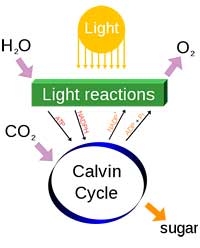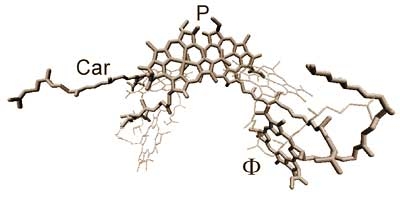
Photosynthesis works with valves
Photosynthesis is the origin of life on earth, but it is a phenomenon that is still barely understood. Take, for example, the extremely efficient mechanism of electron transport. Leiden researchers demonstrate for the first time where one particular cause of this might be found.

PNAS
In the early edition of the PNAS journal (Proceedings of the National Academy of Sciences of the United States of America) the researchers from the Leiden Institute of Chemistry (LIC) and the Leiden Institute of Physics (LION) along with a researcher from the ETH Zurich describe the electronic structure of a protein that is involved in photosynthesis. This is the first time that scientists have succeeded in doing this at atomic level using a method they developed specifically for the purpose.
Photolysis
There are two parts to photosynthesis: light and dark reactions. First, water is split into electrons, protons and oxygen in the light reactions, and chlorophyl molecules then convert light particles into electrons. The electrons and protons are then transported to a reaction centre where they are converted into chemical energy. This energy is used in the dark reactions to produce glucose from carbon dioxide.
Electron pump
Photosynthesis is a strange process, from the viewpoint of chemistry, because the direction of the reaction ought to be reversed. A strong energy source is needed to enable the reaction to take place, so that the electrons can be propelled in the right direction. Plants and bacteria apparently have such a powerful electron pump, and one that works extremely efficiently. The question of how it works is something scientists have been researching for many years.
Zoom in
A major step towards understanding this phenomenon was made by Hartmund Michel. He first exposed the structure of a protein in a photosynthetic membrane using X-rays, for which he was awarded the Nobel Prize for Chemistry in 1986. Once the structure was clear, the process still had to be understood. Scientists managed this fairly successfully, albeit at molecular level. The Leiden researchers have now for the first time been able to zoom in at atomic level. They used a new spectroscopic method, known as laser-flash photo CIDNP MAS NMR.

PhD researcher Eugenio Daviso, main author of the PNAS article, was responsible for setting up the spectrometer. 'We have been able to reproduce results obtained using old techniques and have also obtained new insights into photosynthesis.' The results have been received enthusiasticallyby Jörg Matysik, his supervisor. 'No-one else in the whole world is able to do this. It is analytically an enormous step forward.'
Valve
By using the spectrometer, Daviso was also able to show clearly for the first time why electron transport goes in one direction. 'We saw that once an electron has passed through the protein, the protein itself changes such that the return route is blocked,' explains Matysik. 'It works just like a valve in a bicycle tyre that lets air in but not out. As you can well understand, this can raise efficiency enormously, as each electron is in real terms transported in the right direction. In artificial systems electron transport often goes in both directions so that such high efficiency can never be achieved. It was very surprising that Eugenio was able to observe this so clearly. Nobody had managed to do this before.'
Laser pulses
The development of the new spectrometer is the cornerstone of Matysik's Vidi project that comes to an end this year. The heart of the method is NMR, Nuclear Magnetic Resonance. The photosynthesis protein in a magnet is cooled to -60 degrees Celsius, and the nuclei in the protein are then struck by short laser pulses. The nuclei will revert to their original state, emitting a signal. By collecting the nuclear signals, Daviso was able to determine the electronic structure of the protein, up to atomic level.

Driver
As well as providing the subject for his first PNAS article, this method has brought Daviso a number of prizes, including the eminent Magnetic Resonance in Chemistry Award for Young Scientists 2008. In his search for the ultimate method he was able to rely on strong support from his colleagues and experts in electron experimentation. But his own enthusiasm was an important driver. 'I already knew as early as twelve years old that I wanted to carry out research on photosynthesis. That was when I first heard about the subject, and I was immediately fascinated by how amazingly well the processes of nature work.'
Previous articles in the University Newsletter
- The secret of a natural energy source (24 July 2007)
- Sustainable energy from photosynthesis: 'Europe mustn't lag behind’ (31 March 2009)
- Researchers determine the structure of very efficient light-harvesting antennae in green bacteria (12 May 2009)
- EerFirst step uin converting solar energy using 'artificial leaf' (30 June 2009)
- 25 million for research into energy from plants and algae (14 July 2009)
